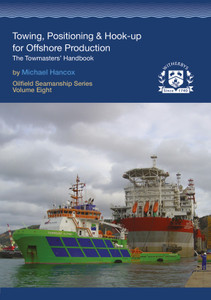
This publication covers the design, installation, operation and maintenance of DP systems for all types of ships. It examines DP functions and applications on offshore ships and includes the latest variants of position reference systems for dual frequency DGPS and relative GPS, including the CyScan laser and the latest Hi PAP technology from Simrad. Previously published by Clarkson Research Services Ltd.
This book explains the principles of dynamic positioning and outlines the features of DP systems. It discusses use of DP for position referencing and manoeuvring, with a particular focus on offshore operations. It also looks at the role of the crew in watchkeeping and operational planning.
The Oilfield Seamanship series describes and explains standard techniques used in marine operations in offshore oilfields. The series concentrates on towing, anchor handling, barge mooring and moving, the operation of jack-up vessels afloat, the practice of stability control on semi-submersibles and ballast control techniques.
Dynamic Positioning is a relatively new technology, having been born of necessity as a result of the increasing demands of the rapidly expanding oil and gas exploration industry in the 1960s and early 1970s. Even now, when there exists over 1,000 DP-capable vessels, the majority of them are operationally related to the exploration or exploitation of oil and gas reserves.
Since the end of hostilities in 1945, world shipping has undergone many wide-ranging changes. Traditional shipping patterns and trades have changed beyond recognition, and the methods used to achieve the commercial ends of the shipping industry have also altered immeasurably. Passenger liner trades have collapsed totally in the face of competition from universal jet air transport, while cruiseliner traffic is enjoying a major boom. General cargo vessels of the traditional tweendecker variety have also been eclipsed by specialist carriers of various shapes and sizes; the container vessel predominating. Passengers and vehicles are carried across short sea routes in roll-on/roll-off ferries of a size and sophistication unheard of a few decades ago. Bulk cargoes of all descriptions are now lifted in huge but rather unsophisticated tonnage, and all ships nowadays are manned by ever decreasing numbers of personnel from an ever increasing variety of nationalities.
Common to all of the types of vessel mentioned above is the necessity to make a profit, and with the majority of ships the profits arise from making passages at sea; a ship tied up in port is making no money for her owner. The priority in naval architecture terms was to design vessels that would be most economical at designed (usually close to maximum) speed, and to show expediency in turn-round arrangements in port. Sophistication within the vessel’s manoeuvrability was of a lower priority, and mainly provided in order to reduce the expense of and reliance upon tug assistance during port arrival and departure. Normal trading vessels generally sport main propellers and rudders optimised for full power economy, together with maybe a bow thruster. Only a small fraction of trading vessels are fitted with greater manoeuvrability, and these tend to be the ferries, where precise manoeuvrability is required for reliable berthing and unberthing, sometimes many times in any day.
The advent of the offshore oil and gas industry has brought about a whole new set of needs and requirements. Further to this, the more recent moves into deeper waters, together with the requirement to consider more environmental-friendly methods, has brought about the great development in the area of Dynamic Positioning techniques and technology.
Chapter 1 – Introduction to Dynamic Positioning
Chapter 2 – DP Systems
Chapter 3 – Position Reference Systems
Chapter 4 – Thrusters and Manoeuvring Systems
Chapter 5 – Power Systems
Chapter 6 – DP Operations and Vessel Types
Chapter 7 – Redundancy
Chapter 8 – Watchkeeping and Operational Planning
Chapter 9 – Industrial and Charterers’ Requirements and Considerations
Chapter 10 – Personnel Training and Human Factors
Appendix – The IMO Guidelines
Witherby Publishing Group
Witherbys titles are developed using scripts developed by technical experts that are peer reviewed within work groups. Typically, they seek to improve understanding of the regulations, recommendations and guidelines issued by Industry.
Witherbys staff have significant expertise in the fields of navigation and hazardous cargoes as well as in the presentation of complex subjects in a graphic and easy to understand manner.
- Number of Pages:
- 319
- ISBN:
- 9781902157443
- Published Date:
- September 2003
- Binding Format:
- Paperback
- Book Height:
- 295 mm
- Book Width:
- 210 mm
- Weight:
- 1.1 kg
- Author:
David Bray FNI
- Preview:
- Yes
 Witherbys.com
Witherbys.com





